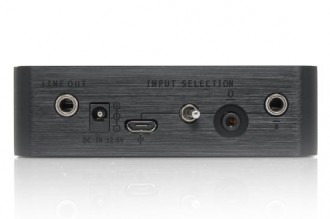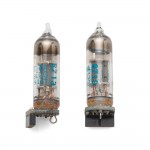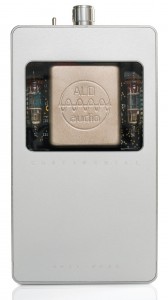ALO Audio, famous for their high-quality aftermarket cables, portable equipment, and Studio Six headphone amplifier, is on fleek this summer with their new tube-based portable that is simply out of this world amazing and among the coolest pieces of gear that I have had the privilege of reviewing thus far. The Continental Dual Mono (CDM) is ALO Audio’s latest release and at $1495, serves as the new flagship for their portable line. The CDM is a semi-portable hybrid headphone amplifier and DAC combo created through a collaboration between ALO Audio and Vinnie Rossi of Red Wine Audio. As a result, the CDM has an impressive tech spec sheet and features mono balanced tube and SS amplification, a kick-ass DAC with DSD capabilities, high-quality low-noise battery-powered circuitry, and an awesome form-factor that’s similar to that of the Studio Six. The sound? Incredible!
Design

The ALO Continental Dual Mono features a semi-portable design, which is probably too large to fit in your pocket, but great for a small portable rig that is easy to setup and move around. The 100% CNC machined aluminum enclosure is available in either black or silver, with a soft-touch matte finish and brushed aluminum sizes. The CDM has a clear Gorilla Glass window that allows you to see observe both 6111 tubes and the ALO logo between them. The build quality of the CDM is solid throughout and the aesthetics are contemporary, minimalist, and clean.
Accessories included with the CDM are a few elastic bands to hold your portable rig together, a drawstring carrying bag, a wall charger, and a Green Line micro USB cable ($149 value). Though the accessories are minimal, the fancy ALO cable adds a nice touch.
The Continental Dual Mono features both balanced and single-ended inputs and outputs. Though the amplifier can run in both single-ended and balanced, the DAC unfortunately can only output single-ended. An input switch is located on the side to switch between analog inputs and USB input if you decide to use the CDM’s internal DAC.
The CDM takes digital conversion seriously as it features a well-designed and competent DAC section. The CDM uses Wolfson’s flagship WM8741 DAC chip which has low noise and distortion numbers and sounds fantastic. A high-quality clock IC additionally helps keep jitter as low as possible. The DAC is compatible with both Windows and MAC computers and supports up to 24-bit/192kHz PCM conversion as well as DSD 64. Depending on the sample rate of whatever you’re playing, the CDM will display a different colored LED (Red for 44/48, Green for 176/192, Blue for 88/96, and White for DSD).
Mobile decides can also be paired effortlessly with the DAC as both Apple and Android devices are supported. Drivers are required for computer and Android use but not for iDevices. I was able to connect the CDM to my iPad Air with the included USB cable and the Apple Camera Connection Kit adapter (CCK), the iPad immediately recognized the DAC and set it as my default sound option with no volume control from the iOS; it was a direct connection. Playback and conversion were flawless throughout all applications including Tidal, JRiver, iTunes, Youtube, and various games, however it is worth noting that iDevices only support PCM conversion and cannot send DSD to the CDM.
The CDM also features a dedicated single-ended line out. The 2V analog signal is output directly from the DAC’s analog output, completely independent from the amplifier sections of the CDM. The CDM is able to function as a stand-alone powered DAC and can provide a line-level signal to full-size headphone amplifiers, pre-amps, and other equipment. Unlike other portable amp/DACs, the DAC portion of the CDM has its own power independent from the USB and amplifier sections, which helps keep digital harshness and noise to a minimum.

The Continental Dual Mono’s battery powered circuitry is designed to deliver clean power to the amplifier, DAC, and tubes. Low-noise and crosstalk is important in a portable rig so the CDM uses separate linear voltage regulators throughout. Dedicated linear voltage regulators provide clean voltage to different components in the amp and DAC. By keeping component voltages independent of each other and using linear regulators rather than switching regulators, components receive clean voltage waveforms needed for proper balanced tube amplification and DAC performance. The CDM has no interference issues and low-noise levels that do not change regardless of what’s connected to it or whether its charging or not.
The Continental Dual Mono battery pack is made up of three Panasonic 18650 cells. The battery is good for 1000 cycles, is user replaceable, and features short circuit and overcharge protection. Battery life is approximately 7 hours and slightly less if you decide to use the DAC. The included charger adds no noise to the unit while charging and has an LED indicator to let you know when the CDM is fully charged.
The Continental Dual Mono’s hybrid amplifier is pretty much the best I’ve heard out of any portable amplifier on the market. The CDM uses two NOS 6111 tubes running in Class A to provide the current gain needed for the solid-state output stage of the amplifier. The tubes run in dual mono, meaning that the left and right channels have separate amplification and each channel uses a tube. The amp is also free of DC/DC converters and transformers, which helps give the CDM a silent black background and increased soundstage and imaging.

The stock tubes included with the Continental Dual Mono are a pair of NOS Philips 6111WA tubes. Tube rolling is possible, but because the small tubes lack the traditional tube pins and sockets most of us are used to, the process little more involved. Rather than being directly soldered to the CDM’s main board, the tubes are soldered to a special 8 pin header PCB board that can be removed. ALO Audio makes tube rolling as easy as possible by offering several different tubes for sale on their website which are already soldered to the PCB, so all you need to do is open the amp up and switch them out. For those who want to roll a wider variety of tubes, a dedicated tube rolling thread with a list of compatible tube types is available on Head-Fi.org. ALO Audio also has a detailed FAQ for the CDM which includes links to videos that demonstrate how to safely open the CDM and explain the tube rolling process in more depth.
The Class AB solid-state output stage of the CDM’s hybrid amplifier complements the tubes by adding bass punch, speed, and precision to the overall sound signature of the Continental. Output impedance is also kept low as it is less than 1 ohm. The solid-state design is kept simple and sweet, and uses high-quality voltage regulators, capacitors, and resistors throughout in order to maintain transparency and a tube-focused presentation.
Power numbers on the Continental Dual Mono are healthy and enough for most non-planar headphones and IEMs under 300 ohms, especially when driving them out of the balanced outputs. Maximum single-ended output is 95mW into 50 ohms and a low of 60mW into 300 ohms. Balanced outputs will provide up to 145mW into 50 ohms and a minimum of 95mW into 300 ohm. A high and low gain switch on the side of the CDM allows for listening to both full-size headphones and IEMs as well as other sensitive headphones.
The low gain is practically noise-free and worked fantastic with my Noble 6C custom in-ear monitors. High gain is significantly more powerful and I was able to drive my Sennheiser HD 800s effortlessly while using it. The CDM feels capable enough to handle any headphone, experiencing no loss in dynamics or signs of strain at any volume, but of course, you will eventually run out of volume headroom if you try and power a 600 ohm Beyerdynamic or planar magnetic headphone with it.
Equipment
For this review, I used the Sennheiser HD 800 headphones and my Noble 6C custom in-ear monitors. The Continental Dual Mono kept its stock Philips 6111WA tubes throughout my listening and I never felt like I needed to tube roll, which is a good thing. As my headphones are single-ended, my listening impressions are based off of the CDM’s non-balanced outputs. My source was primarily lossless files fed from my computer directly via USB. I also streamed lossless files from my iPad Air 2 to the CDM by using either JRiver Media Center’s network streaming app when I was at home or Tidal’s lossless streaming service when moving around; both were easy to setup and playback was flawless! As usual, my music choices varied and included just about everything.
Sound
The Continental Dual Mono sounds like a full-size tube amplifier, with a sweet, refined, and inviting sound that is easy to become addicted to. The treble is smooth and forgiving, yet detailed and extended. The midrange is warm with a euphonic and natural tube tonality, but it also possesses solid-state qualities offering crispness and a dynamic presentation. Bass is punchy, focused, and tight, with a clean decay. The mid-bass hits hard like a solid-state amplifier and the sub-bass goes down deep, yet remains neutral overall.Unlike many portable amplifiers, the CDM is also fast, transparent, and pretty much devoid of any grain. The silent noise-free background of the amplifier aids greatly in soundstage and imaging, as instruments and vocals emerge effortlessly out of the blackness.
The CDM’s DAC sounds fantastic as well. Every digital bit is flawlessly converted into beautiful music as there is not a trace of digital harshness or grain present in the sound. The DAC works well in tandem with the tubes and solid-state components to create a coherent sound signature that is easy to fall in love with. The CDM is so good it’s hard to find a fault!
Most of my listening on the CDM was done with my Noble Audio 6C custom in-ear monitors. Having just received them shortly before this review, I was struggling to find proper amplification for them. Though they sounded fantastic out of my iPod as well as my two reference amplifiers, the Woo Audio 5 and Headamp GSX MK2, neither was adequate. The iDevice lacked the digital refinement and power I was looking for and the full-size headphone amps had a higher noise floor than I am used to, which took away from the otherwise awesome sound. Plugging the 6C into the single-ended output of the CDM, the differences were immediately obvious, it was no contest. The Continental Dual Mono offered a wide and expansive presentation similar to the WA5, with a velvety midrange and a deep enveloping soundstage, as well as bass that was punchy and controlled like my GSX.
Like these flagship amplifiers, the CDM brought out a clarity in the CIEMs that most normal gear cannot do, those nuances, those extra layers in the sound, the small details, it did it all. The warm, seductive analog warmth of tubes, that beautiful tonality, the 3D imaging, was ever present in the CDM as it was in other top-level tube amplifiers I have heard. Though the CDM still lacks some of the effortless liquidity and resolution that the WA5 and GSX possess, the low-noise floor and coherent sound of the CDM more than made up for it. The Noble 6C really came alive with this amplifier!
The CDM also works wonders with full-size headphones, as it paired surprisingly good with my Sennheiser HD 800s. The HD 800s, being quite neutral sounding, are extremely revealing of any equipment flaws and will let you know what your system truly sounds like. The HD 800 however, proved to be a sublime pairing with the CDM as I experienced everything I could have hoped for. Palpable vocals, unveiled treble extension and details, lifelike dynamics, and punchy bass were all present. Comparing the Continental with the WA5 isn’t easy, as they’re extremely different in terms of size, design, and pricing.
The WA5’s 300B tubes focus on delivering a smooth, rounded, and open sound, beautiful and liquid, with tons of spatial cues. The CDM offers many of the same qualities, having a wide open soundstage, incredible imaging, and harmonic richness in spades, but it still falls short of WA5 levels as the Woo simply resolved more of the recording. The CDM however, has a punchier more dynamic sound thanks to its solid-state components and is no slouch when it comes to driving the 300 ohm load. Additionally, the CDM’s lushness and forgiving nature tamed the sometimes peaky HD 800, and allowed me to listen to my entire library without fatigue even on the worst recordings. The CDM proved to have excellent synergy with the HD 800s and drove them effortlessly, putting a few similarly priced full-size amplifier/DAC systems to shame.
Conclusion

Overall, I have had a blast this summer reviewing the Continental Dual Mono. ALO Audio really knocked it out of the park with this one! The amplifier and DAC combo is impressively engineered and offers highly refined world-class performance that is hard to beat at any price. For those who want to add real endgame tube sound to their portable rig, the CDM should be at the very top of your list, you simply cannot go wrong!















Reply
Want to join discussion?
Feel free to contribute!